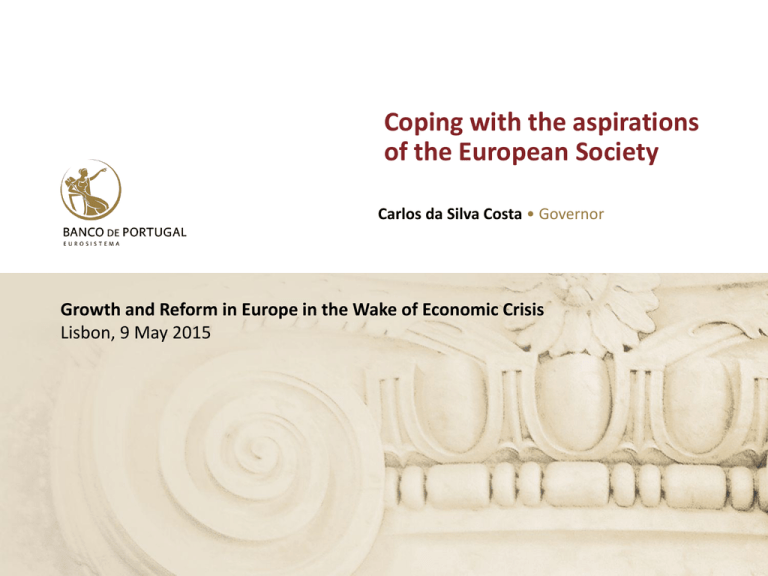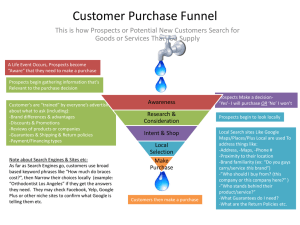Coping with the aspirations of the European Society Lisbon, 9 May 2015
advertisement

Coping with the aspirations of the European Society Carlos da Silva Costa • Governor Growth and Reform in Europe in the Wake of Economic Crisis Lisbon, 9 May 2015 Main Challenge More than seven years after the start of the Great Recession GDP growth in Europe remains sluggish. Is output growth going to remain slow? Reduced prospects for growth in the medium term have important implications for the European society as the income aspirations of citizens (consumption, social protection) will be more difficult to achieve. Raising potential output growth is a priority for policymakers. 2• Growth prospects SLOW GROWTH Demographic trends: • Working age population growth is likely to decline significantly; • Ageing economies typically invest less, presumably because they have less labour to use the new capital; • Increase of life expectancy is likely to increase savings as workers save more to finance consumption through longer retirement; Lawrence Summers ( 2014) – Secular Stagnation “There is increasing concern that we may be in an era of secular stagnation in which there is insufficient investment demand to absorb all the financial savings done by households and corporations, even with interest rates so low as to risk financial bubbles.” 3• Growth prospects SLOW GROWTH Low investment: • Poor prospects and the “vicious circle of reluctance to invest and consume”; • Firms’ response to lower labour force growth; • Debt overhang (Portugal, Spain, Italy, France); • Tighter financial constraints for financial and non-financial firms; • Political uncertainty (Greece) 4• Growth prospects SLOW GROWTH Persistent downward trend in TFP since 1970 • The negative view - (Gordon ,2010, 2014) there were only a few truly fundamental innovations (electricity, internal-combustion engines, plumbing, petrochemicals and the telephone) and they have mostly been made. There will be more innovation but it will not fundamentally change the way the world works; • In addition, human capital growth is expected to slow down as the marginal return to additional education decreases; • The optimistic view – the impact of current innovations such as IT has not been fully realised yet; future inventions are hard to forecast; Annual growth rate of TFP: 10-year moving average %7 6 5 Japan Germany Italy Spain 4 3 2 1 0 -1 1970 5• 1980 1990 2000 Source: AMECO database, February 2015 (last observation: 2014). 2010 Growth prospects HOW TO ENHANCE PRODUCTIVITY GROWTH IN EUROPE? The (New) Schumpeterian view: it is innovation - not capital accumulation - that leads to growth. • Growth in European countries has been driven by incremental innovation while in the US growth has been driven by radical innovation. Radical innovation requires different institutions and policies in Europe. • There are four pillars that characterise a highly innovative economy (Aghion, 2013): 1. Competition: Innovation is a way to escape competition; innovative and productive firms react much better to competition; 2. Very good education and universities: promotion of merit/ entrepreneurship culture; 3. Flexible labour markets: easier to find workers for new firms/ firms that constantly innovate; 4. Finance: rely more on equity finance and stock markets; I add two more conditions: 5. The existence of market/demand for the product (versus market fragmentation); 6. Society's ability to deal with failure; 6• Policies and Reforms IMPROVE GROWTH PROSPECTS Europe needs to adopt policies and reforms that can permanently boost the level of potential output BUILD ECONOMIES THAT ARE RESILIENT AND FLEXIBLE • Income policy that safeguards competitiveness; • Fiscal policy that ensures the resilience of the adjustment At National level 7• path of public finances; • Policies that promote a shift of investment and resources towards sectors with high productivity (the tradable sector): competition; removing barriers to entry and exit of businesses; diversified sources of finance; • Policies that improve the level of human capital: education and training; • Values and institutions that promote entrepreneurship: universities; mechanisms to deal with failure; • Investment in R&D (public and private); Policies and Reforms IMPROVE GROWTH PROSPECTS Europe needs to adopt policies and reforms that can permanently boost the level of potential output ENHANCED COORDINATION AND FURTHER INTEGRATION • Surveillance and monitoring of the sustainability of At European level 8• national policies (fiscal and income policies) • Reinforce the coordination of national economic policies at the centre taking into account the path of potential output and employment in the area as a whole; • Reinforce the implementation and deepening of the internal market; • Further integration of financial markets: towards a capital markets union; • Mechanisms to compensate the effects of idiosyncratic shocks and the asymmetric effects of common shocks; Carlos da Silva Costa • Governor Growth and Reform in Europe in the Wake of Economic Crisis Lisbon, 9 May 2015







